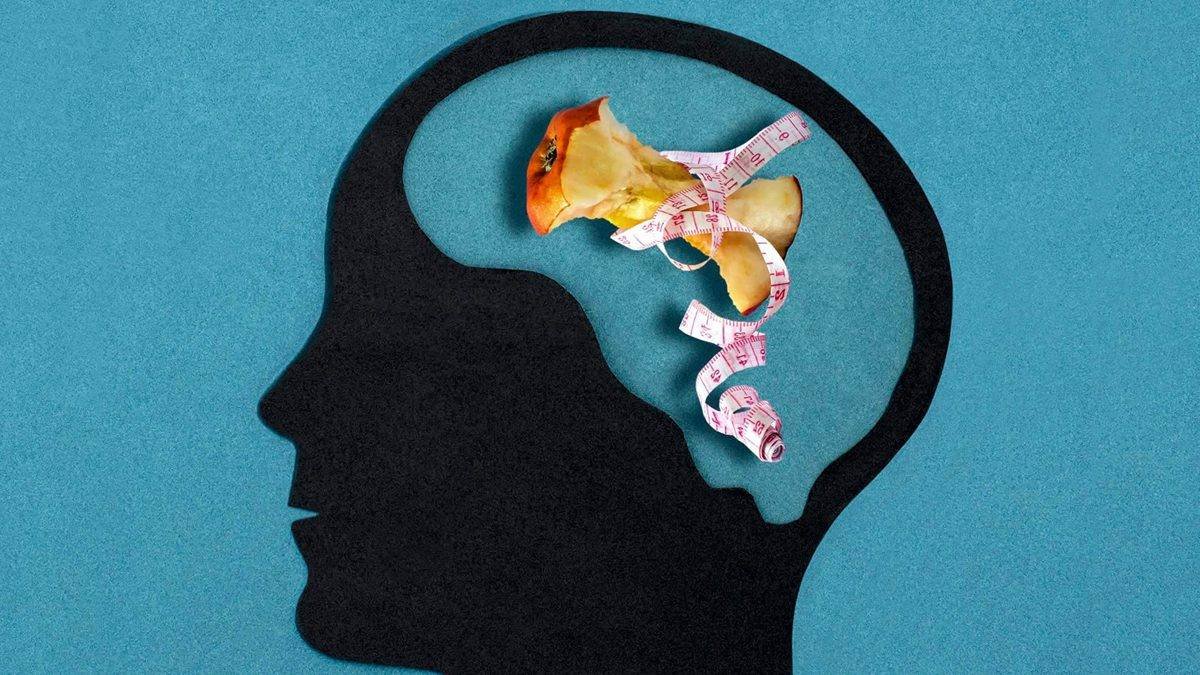Anorexia nervosa and bulimia nervosa are both eating disorders. Anorexia involves people who intentionally starve themselves when they are already underweight. Individuals with anorexia have a bodyweight that is 15 percent or more below recommended levels (as determined by a standard height-weight table). People suffering from this disorder have an intense fear of becoming fat, even when they are extremely underweight, and are usually unable to perceive their physical appearance accurately. Many females with anorexia stop having their menstrual cycle (period) for several months, a condition called amenorrhea.
By contrast, persons with bulimia nervosa consume large amounts of food during “binge” episodes in which they feel out of control of their eating. They try to prevent weight gain following such episodes by vomiting, using laxatives or diuretics, dieting, or exercising aggressively. Persons with bulimia, like those with anorexia, are very dissatisfied with their shape and weight, and their self-esteem is unduly influenced by their appearance. To receive a formal diagnosis of bulimia nervosa, an individual must engage in binging and purging (vomiting, etc.) at least twice a week for three months. However, less frequent episodes of binging and purging may still be very upsetting and require professional assistance.
Anorexia and bulimia sometimes overlap. A minority of persons with anorexia engage in binge eating or purging. This contrasts with “restricting” anorexics who maintain their low body weight by dieting alone. If individual binges and purges, but is 15 percent or more below recommended weight, then anorexia nervosa is the proper diagnosis.
Understanding Your Body & The Disorder
Both anorexia and bulimia are considered psychiatric disorders that have physical complications. Both disorders grow out of worries about having too much body fat. This is particularly true of females. Prior to puberty, boys and girls have about the same percentage of body fat—about nine to 12 percent. However, at the end of puberty, body fat has usually doubled in girls, reaching about 25 percent of body weight, while boys have grown leaner and more muscular. These dramatic changes in the female body type predispose girls to preoccupation and dissatisfaction with their weight.
Persons with anorexia and bulimia feel driven to reduce their weight, usually by dieting (purposefully restricting their food intake). As such, both individuals must fight against their bodies’ natural hunger signals, as well as other biological factors that control eating and body weight. The word anorexia means loss of appetite, but it is really a misnomer because anorectic individuals usually are hungry and are preoccupied with thoughts of food. (Nervosa means nervous.) As weight loss increases and the illness progresses, patients begin to display both physical and psychological consequences, including depression, lack of concentration, and irritability, which are direct consequences of physical starvation. These problems are reversed when anorexic individuals resume eating and gain weight.
Bulimia means “ox hunger,” referring to the large amount of food consumed during binge episodes. Persons with bulimia are not as successful at dieting as anorexics. They may successfully deny their hunger and restrict their food intake for several days or weeks at a time. However, sooner or later, often when they feel emotionally upset, persons with bulimia lose control over their dieting. They begin to eat and cannot stop eating until they have stuffed themselves. Such overeating is thought to compensate for the prior caloric restriction. Binge eating may also result from impaired satiety (feelings of fullness). Many bulimics report that they have trouble feeling full unless they eat
large amounts of food.
Who Gets Anorexia Nervosa & Bulimia Nervosa
Eating disorders seem to be most prevalent in industrialized societies, especially those in which thinness is considered the attractive ideal. About 90 to 95 percent of the cases of anorexia and bulimia nervosa occur in females. Anorexia usually develops in adolescence, between the ages of 14 and 18, while bulimia is more likely to develop in the late teens or early 20s. It is estimated that anorexia occurs in about 0.5 percent of adolescent girls, and bulimia in about 1 to 2 percent, although various symptoms and milder versions of these disorders occur in about 5 to 10 percent of young women. The large majority of women with eating disorders are white, although in recent years the disorder has been increasing in minority women.
Possible Causes
Several factors may play a role in the onset of anorexia and bulimia, including a familial predisposition to these disorders, as well as individual personality characteristics. However, the stage for eating disorders is set by our society’s glorification of thinness and strong prejudice against those who are overweight. The thin ideal is portrayed in the media (for example, using fashion models and movie stars) and is often linked with social desirability and achievement. As a result, girls and young women are now dieting in record numbers in quest of a leaner shape.
It should be noted that both anorexia and bulimia nervosa were well-documented before the thinness ideal reached its current state, suggesting that this factor alone is not sufficient for the onset of an eating disorder. It may, however, be linked to the increase of cases of both anorexia and bulimia in recent years.
What separates individuals who diet and develop an eating disorder from those who do not experience complications? Genetic studies have found that anorexia nervosa is five times as likely to co-occur in monozygotic (identical) twins than in dizygotic (fraternal) twins or non-twin siblings, suggesting a biological component in the onset of the disorder. In fact, data suggest an increased risk for both anorexia and bulimia nervosa in first-degree biological relatives of an individual with the disorder.
Certain personality characteristics also seem to be associated with these two disorders. Such predisposing factors include the fear of losing control, inflexible thinking, a tendency toward perfectionism, self-esteem which is unduly determined by the individual’s view of her or his body shape and weight, dissatisfaction with body shape, and an overwhelming desire to be thin. Anorexia nervosa also has been linked to obsessive-compulsive tendencies, such as a preoccupation with thoughts of food, while mood disturbances, such as depressed mood or social anxiety, have been associated with bulimia nervosa.

